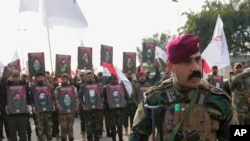
The head of the United Nations' nuclear watchdog said Tuesday he's hopeful that meetings this week with Iranian officials, including the country's new president, can lead to a breakthrough in monitoring the country's nuclear program, a longstanding issue that has gained new urgency as Israel has twice struck Iran amid rising tensions in the Middle East.
Rafael Mariano Grossi, director general of the International Atomic Energy Agency, will travel to Iran on Wednesday to meet for the first time with President Masoud Pezeshkian, who was elected in July. Grossi said he hopes to build on positive discussions he had with Iranian Foreign Minister Abbas Araghchi during the U.N. General Assembly in September.
"We have a problem that we need to solve," Grossi said in an interview at the U.N. climate conference in Azerbaijan. "That is this gap, this lack of confidence, which we should not allow to grow into a self-fulfilling prophecy of using nuclear facilities as targets."
He added: "There has been a bit of a dire straits dynamic with Iran that we want to go beyond."
Iran is rapidly advancing its atomic program while increasing stockpiles of uranium enriched to near weapons-grade levels, all in defiance of international demands, according to the IAEA. Iran says its program is for energy purposes, not to build weapons.
Grossi's visit comes as Israel and Iran have traded missile attacks in recent months after more than a year of war in Gaza, which is governed by Hamas, a group supported by Iran.
Grossi noted that international law prohibits the attack of nuclear facilities and "it's obvious that is something that can have radiological consequences." The Biden administration said last month that it had won assurances from Israel that it would not attack nuclear or oil sites.
A 2015 nuclear agreement between Iran and world powers put limits on Iran's nuclear program, which the West fears could be used to make nuclear weapons. The deal included the lifting of economic sanctions on Iran.
But that deal collapsed after Donald Trump's administration in 2018 pulled the United States from it. That led Iran to abandon all limits put on its program and enrich uranium to up to 60% purity.
When asked if the IAEA feared Iran may be developing a bomb, Grossi said he didn't "have any information that would sustain that."
He added that inspectors' job was not to "judge intentions," but rather verify that what Iran says about its nuclear program was true.
Trump's reelection last week raises questions about whether and how the incoming administration and Iran may engage.
Grossi said he had worked with the first Trump administration, which he said engaged in "seamless, professional work," and looked forward to looking with Trump's second administration.
"Circumstances have changed in that the problem has grown bigger than it was," said Grossi. "The problem of not finding a solution."







